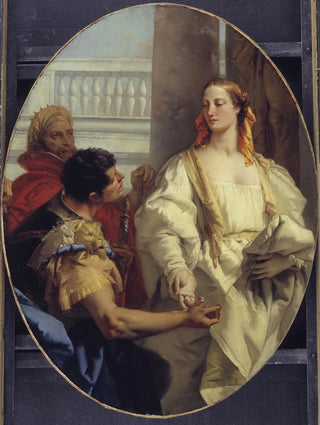Art print | Latinus offering his daughter Lavinia in marriage to Aeneas - Giovanni Battista Tiepolo


View from behind

Frame (optional)
Latinus art print offering his daughter Lavinia in marriage to Aeneas - Giovanni Battista Tiepolo – Captivating introduction
In the vast panorama of art history, some works stand out for their ability to capture moments of great narrative intensity. The Latinus art print offering his daughter Lavinia in marriage to Aeneas - Giovanni Battista Tiepolo is one of these masterful pieces that transcend the simple pictorial frame to immerse us in a mythological story rich in emotions and symbols. This work, illustrating a fundamental episode of the Virgilian epic, invites us to explore themes of love, destiny, and heritage. By depicting King Latinus offering his daughter Lavinia to the Trojan hero Aeneas, Tiepolo transports us to a world where gods and men intertwine, where human choices are often guided by higher forces.
Style and uniqueness of the work
Giovanni Battista Tiepolo's style is immediately recognizable by its dazzling brightness and sense of movement. In this piece, the composition is orchestrated with remarkable fluidity, where the figures seem to dance across the canvas. The drapery of the clothing, with its delicate folds, creates a play of light that brings the characters to life. Tiepolo excels in the art of visual storytelling, and every element of the scene is carefully thought out to enhance the emotional impact of the whole. The faces, expressive and full of meaning, reveal the complex feelings of the protagonists: Lavinia’s joy mixed with apprehension, Aeneas’s determination, and Latinus’s paternal kindness. This painting is not limited to a simple representation but becomes a true theater where universal human passions are expressed.
The artist and his influence
Giovanni Battista Tiepolo, one of the undisputed masters of rococo, marked his era with an innovative approach to painting. Originating from Venice, he knew how to combine tradition and modernity, integrating baroque elements while developing a personal style imbued with lightness and grace. His influence extends well beyond Italian borders, affecting artists throughout Europe. By highlighting mythological and historical themes, Tiepolo contributed to redefining

Matte finish

View from behind

Frame (optional)
Latinus art print offering his daughter Lavinia in marriage to Aeneas - Giovanni Battista Tiepolo – Captivating introduction
In the vast panorama of art history, some works stand out for their ability to capture moments of great narrative intensity. The Latinus art print offering his daughter Lavinia in marriage to Aeneas - Giovanni Battista Tiepolo is one of these masterful pieces that transcend the simple pictorial frame to immerse us in a mythological story rich in emotions and symbols. This work, illustrating a fundamental episode of the Virgilian epic, invites us to explore themes of love, destiny, and heritage. By depicting King Latinus offering his daughter Lavinia to the Trojan hero Aeneas, Tiepolo transports us to a world where gods and men intertwine, where human choices are often guided by higher forces.
Style and uniqueness of the work
Giovanni Battista Tiepolo's style is immediately recognizable by its dazzling brightness and sense of movement. In this piece, the composition is orchestrated with remarkable fluidity, where the figures seem to dance across the canvas. The drapery of the clothing, with its delicate folds, creates a play of light that brings the characters to life. Tiepolo excels in the art of visual storytelling, and every element of the scene is carefully thought out to enhance the emotional impact of the whole. The faces, expressive and full of meaning, reveal the complex feelings of the protagonists: Lavinia’s joy mixed with apprehension, Aeneas’s determination, and Latinus’s paternal kindness. This painting is not limited to a simple representation but becomes a true theater where universal human passions are expressed.
The artist and his influence
Giovanni Battista Tiepolo, one of the undisputed masters of rococo, marked his era with an innovative approach to painting. Originating from Venice, he knew how to combine tradition and modernity, integrating baroque elements while developing a personal style imbued with lightness and grace. His influence extends well beyond Italian borders, affecting artists throughout Europe. By highlighting mythological and historical themes, Tiepolo contributed to redefining






